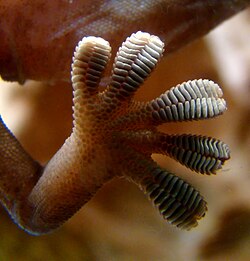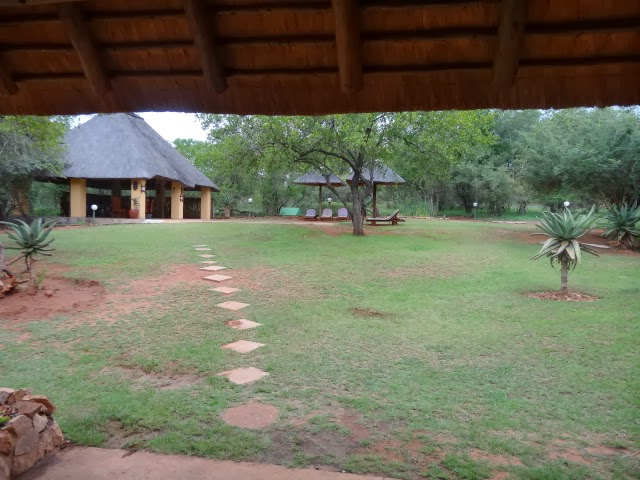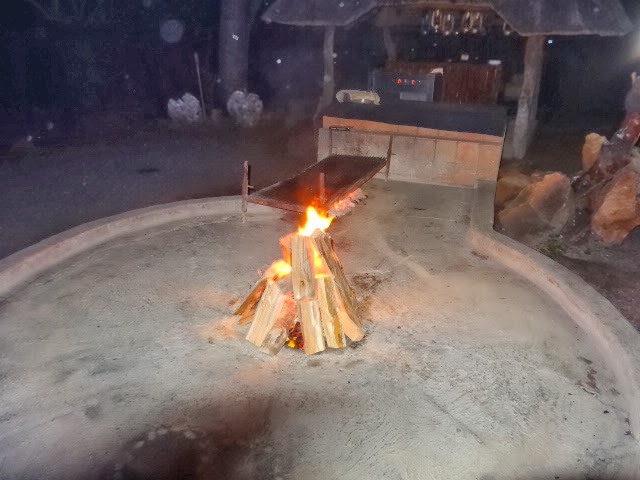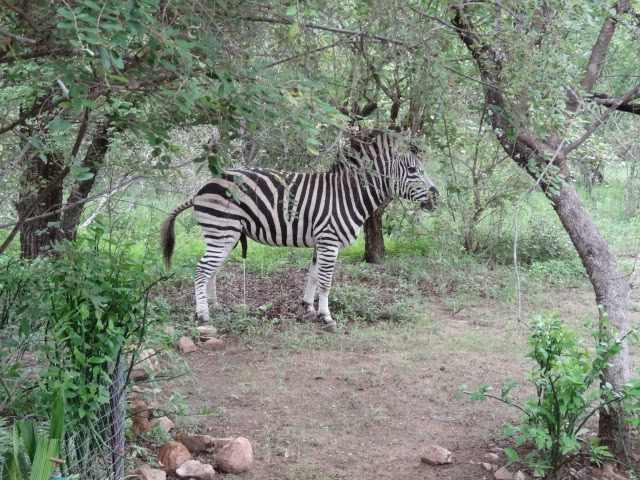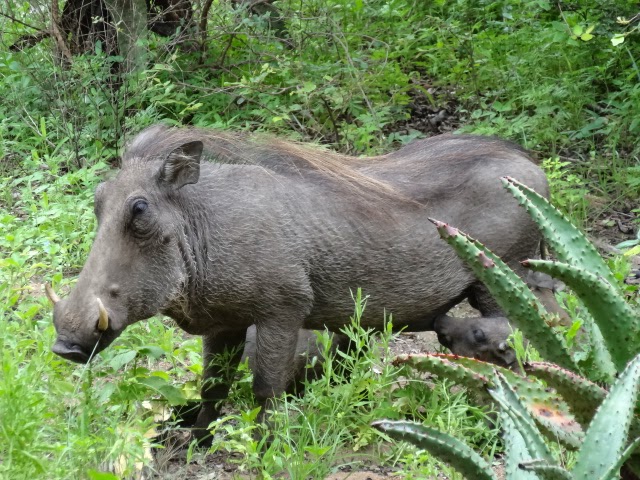 |
| Zef, our houseman, held this monstrous insect Tom had fished out of the pool with the net. |
It would be easy to sit back waiting for wildlife to visit us as we lounge on the veranda. But “easy” doesn’t always ensure the excitement and adventure of discovery. With our curiosity and passion to explore we’ve found a world of small things as intriguing as the big things.
 |
| It’s difficult from the photo to determine the enormous size of this insect swimming for its life. We may have saved its life getting it out of the water. It took a full day of hanging upside down on the tree limb to finally fly away. We might have thought it was a bird if we’d seen it in flight. |
It all started with this photo of the most enormous insect we’d ever imagined possible that apparently fell into the pool after Tuesday night’s rain.
 |
| After Zef gently placed the monstrous insect on a limb on the tree, it grabbed hold of the branch, hanging on for nearly a full day. |
Tom tapped me on the shoulder, saying, “Don’t be scared. I have to show you something.” It was still in the pool, swimming feverishly for its life. Much to my surprise, when I saw it, I wasn’t scared, just curious, and anxious to take a photo.
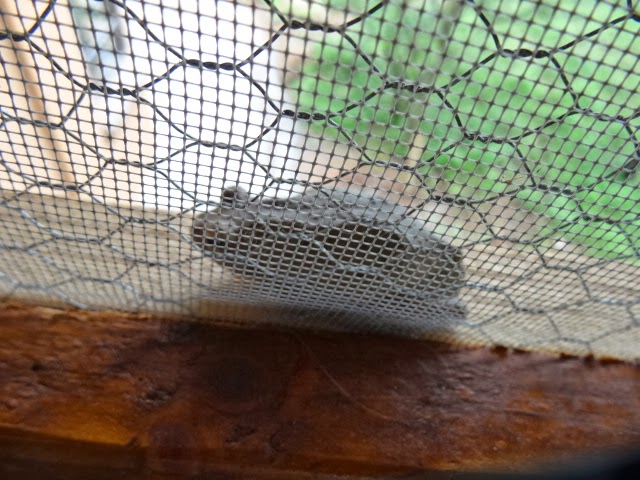 |
| A frog on the outside of a window. Most frogs are active at night. We frequently heard them, but seldom saw them. |
Zef, our hard-working houseman was here cleaning, prompting us to ask him what this huge thing was and if it was poisonous. He assured us it wasn’t poisonous, just huge. Tom then fished it out of the pool with the net.
 |
| Not all small things are alive. Thank goodness, this Scorpion expired in the pool during the storm. |
Without giving it a thought, Zef picked it out of the net, holding it up for these photos. After we’d taken a few photos, Zef placed it on a tree, where it hung for a full day (see above photo), perhaps recovering from its lengthy swim in the pool. We kept an eye on it, but 24 hours later it was gone. We haven’t seen it since.
 |
| This blue flower, a less common color in the wild, caught our eye in our yard. |
We must have spent hours researching information about this giant insect to no avail. Perhaps, one of our worldwide readers will be familiar with it. If so, please post a comment at the end of today’s post. We’d love to know more.
 |
| These tiny birds, the Red-billed Oxpecker (Tick Birds) eat insects off of the giraffes warning them of potential dangers. |
It was this discovery that prompted us to begin the process of finding “Small Things.” One could easily spend a lifetime, as some do, finding the many small curious creatures and plants in this wildlife and vegetation rich tropical climate. All we ever need to do in most cases is simply take the time to look.
 |
Geckos are everywhere, both inside and outdoors. Louise showed us how to identify their poop which contains a small white bead in the center, often found on stone floors, on countertops, and on furniture throughout the house.
 Last night, we got this shot of the underside of a gecko as it crawled on the outside of the sliding glass door in one of the living rooms. (Gosh, in Diani Beach, Kenya we had no living room. In Marloth Park, South Africa we have two living rooms and we spend all day outside.
|
As the search for “Small Things” began, we were surprised to find many more interesting plants and creatures.
 |
| This was our first photo of a dung beetle, yet to create his dung ball. |
My mission, since arriving in Africa, has been to find the dung beetle, an objective now fulfilled, as evidenced by these photos. They are everywhere. One need only look along the driveway where the animals enter our property where there’s plenty of dung and subsequently, plenty of dung beetles, such interesting creatures.
 |
| This was our first photo of the dung beetle in action. The female often sits atop the ball of dung while the male moves it along using his back feet while his front feet grasp the ground for stability. The female lays eggs in the ball so she tags along as he rolls as they search for an adequate hole in which to bury the ball. The ball is used as sustenance for both of them as well as the maturing larvae. |
 |
| “Ah!” he says, “Let’s get this dung ball into this hole before someone decides to steal it from us.” Dung beetles have been studied and they are known to steal the dung balls from one another. |
I know this is hard to believe but Dung Beetle navigate using the Milky Way. Here are some interesting facts about dung beetles. In addition, there’s this amazing fact about the dung beetle:
“The individual strength record goes to a male onthphagus taurus dung beetle, which pulled a load equivalent to 1,141 times its own body weight. In human terms, that would be comparable a 150 lb. person pulling 80 tons!”
 |
| Another dung beetle couple aiming for a hole for their growing family. |
In our research regarding the dung beetle, we discovered a fact that made us howl with laughter. While in Italy and Kenya, we ran and hid whenever an enormous black hornet buzzed us, assuming it was in the hornet/wasp/bee family. With both of us allergic to bees, wasps, and hornets, we were terrified of being stung.
 |
| With no specific landscaping in our yard, it’s interesting to see an occasional flower. In Marloth Park, the homeowners are to keep the natural bush environment to ensure abundant vegetation for wildlife. |
It’s loud buzzing noise alerted us several times a day that it was in the vicinity. We’d quickly take action to get out of its way. We’d researched without luck trying to find information about what we’d assumed to be an enormous black wasp.
 |
| Millipedes are commonly seen in this area which are harmless to humans although they emit a poisonous secretion that when coming in contact with human skin may cause an itchy rash. For the various insects it eats, this venom proves deadly. |
Last week, while visiting with Louise and Dani, they explained that the loud black buzzing thing is in fact a dung beetle in flight (without its dung ball in tow). What do we know? We’ve only been traveling the world for over a year. Now, when we hear that loud buzzing sound, we look and laugh, no longer fearful (although we’ll continue to keep a watchful eye for hornets, wasps, and bees).
 |
| These mushrooms are growing in our yard. Of course, we won’t eat them without knowing if they’re safe for consumption. |
With over two and a half months left for us to live in this wildlife and vegetation rich location, we’ll continue to gather information and photos of the “Small Things,” which we’ll share with our readers from time to time. We need only to remember to look down or around us for the “Small Things” that God/Mother Nature created, all with the purpose of nourishing the earth and its inhabitants.
As Tom would say, “At least we’re no longer like the dung beetles hauling all their sh_ _ with them everywhere we go!”
Tomorrow, we’ll be back with our most extraordinary day yet in Marloth Park with visitors we’d find only in our dreams. Then again, every day has been magical.


